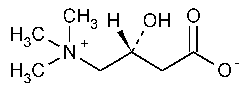Levocarnitine
»Levocarnitine contains not less than 97.0percent and not more than 103.0percent of C7H15NO3,calculated on the anhydrous basis.
Packaging and storage—
Preserve in tight containers.
Identification,Infrared Absorption á197Kñ—
The test specimen and the Reference Standard are dried previously in vacuum at 50 for 5hours.
for 5hours.
pHá791ñ:
between 5.5and 9.5in a solution (1in 20).
Water content á921ñ:
not more than 4.0%.
Residue on ignition á281ñ:
not more than 0.5%.
Chloride á221ñ
—A0.090-g portion shows no more chloride than corresponds to 0.50mLof 0.020Nhydrochloric acid (0.4%).
Limit of potassium—
[NOTE—The Standard solutionand the Test solutionsmay be modified,if necessary,to obtain solutions of suitable concentrations,adaptable to the linear or working range of the instrument.]
Standard solution—
Transfer 5.959g of potassium chloride,previously dried at 105 for 2hours and accurately weighed,to a 250-mLvolumetric flask,dilute with water to volume,and mix.This solution contains 12.5mg of potassium per mL.Dilute an accurately measured volume of this solution quantitatively,and stepwise if necessary,with water to obtain a solution containing 31.25µg of potassium per mL.
for 2hours and accurately weighed,to a 250-mLvolumetric flask,dilute with water to volume,and mix.This solution contains 12.5mg of potassium per mL.Dilute an accurately measured volume of this solution quantitatively,and stepwise if necessary,with water to obtain a solution containing 31.25µg of potassium per mL.
Test solutions—
Transfer 62.5mg of Levocarnitine to a 100-mLvolumetric flask,dissolve in and dilute with water to volume,and mix to obtain a stock solution.To three separate 25-mLvolumetric flasks add 0,2.0,and 4.0mLof the Standard solution.To each flask add 20.0mLof the stock solution,dilute with water to volume,and mix.These solutions contain 0(Test solution A),2.5(Test solution B),and 5.0(Test solution C)µg per mLof potassium.
Procedure—
Concomitantly determine the absorbances of the Test solutionsat the potassium emission line at 766.7nm with a suitable atomic absorption spectrophotometer (see Spectrophotometry and Light-Scattering á851ñ)equipped with an air–acetylene flame,using water as the blank.Plot the absorbances of the Test solutionsversus their contents of potassium,in µg per mL,draw the straight line best fitting the three points,and extrapolate the line until it intercepts the concentration axis.From the intercept determine the amount,in µg,of potassium in each mLof Test solution A.Calculate the percentage of potassium in the portion of Levocarnitine taken by multiplying the concentration,in µg per mL,of potassium found in Test solution Aby 0.2:not more than 0.2%is found.
Limit of sodium—
[NOTE—The Standard solutionand the Test solutionsmay be modified,if necessary,to obtain solutions of suitable concentrations,adaptable to the linear or working range of the instrument.]
Standard solution—
Transfer 6.355g of sodium chloride,previously dried at 105 for 2hours and accurately weighed,to a 250-mLvolumetric flask,dilute with water to volume,and mix.This solution contains 10.0mg of sodium per mL.Dilute an accurately measured volume of this solution quantitatively,and stepwise if necessary,with water to obtain a solution containing 250µg of sodium per mL.
for 2hours and accurately weighed,to a 250-mLvolumetric flask,dilute with water to volume,and mix.This solution contains 10.0mg of sodium per mL.Dilute an accurately measured volume of this solution quantitatively,and stepwise if necessary,with water to obtain a solution containing 250µg of sodium per mL.
Test solutions—
Transfer 4.0g of Levocarnitine to a 100-mLvolumetric flask,dissolve in and dilute with water to volume,and mix to obtain a stock solution.To three separate 25-mLvolumetric flasks add 0,2.0,and 4.0mLof the Standard solution.To each flask add 20.0mLof the stock solution,dilute with water to volume,and mix.These solutions contain 0(Test solution A),20.0(Test solution B),and 40.0(Test solution C)µg per mLof sodium.
Procedure—
Concomitantly determine the absorbances of the Test solutionsat the sodium emission line at 589.0nm with a suitable atomic absorption spectrophotometer (see Spectrophotometry and Light-Scattering á851ñ)equipped with an air–acetylene flame,using water as the blank.Plot the absorbances of the Test solutionsversus their contents of sodium,in µg per mL,draw the straight line best fitting the three points,and extrapolate the line until it intercepts the concentration axis.From the intercept determine the amount,in µg,of sodium in each mLof Test solution A.Calculate the percentage of sodium in the portion of Levocarnitine taken by multiplying the concentration,in µg per mL,of sodium found in Test solution Aby 0.003125:not more than 0.1%is found.
Heavy metals á231ñ:
not more than 0.002%.
Assay—
Transfer about 100mg of Levocarnitine,accurately weighed,to a 250-mLflask,and dissolve in a mixture of 3mLof formic acid and 50mLof glacial acetic acid.Add 2drops of crystal violet TS,and titrate with 0.1Nperchloric acid VSto an emerald green endpoint.Perform a blank determination,and make any necessary correction.Each mLof 0.1Nperchloric acid is equivalent to 16.12mg of C7H15NO3.
Auxiliary Information—
Staff Liaison:Lawrence Evans,III,Ph.D.,Scientist
Expert Committee:(DSN)Dietary Supplements:Non-Botanicals
USP28–NF23Page 1119
Pharmacopeial Forum:Volume No.28(1)Page 71
Phone Number:1-301-816-8389
